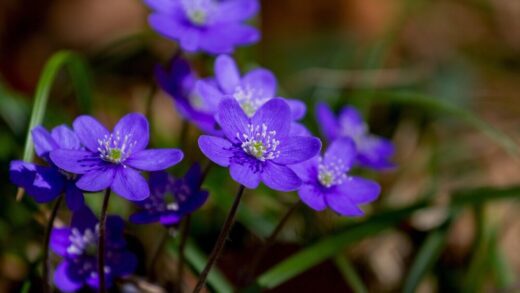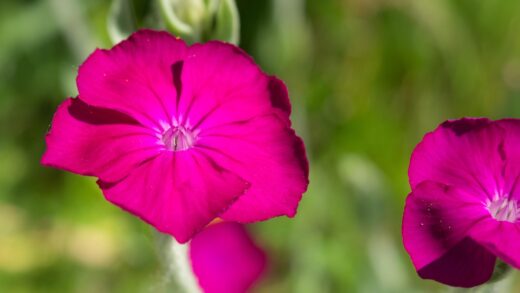When it comes to the topic of pruning Daphne laureola, the most important piece of advice can be summarized in a single word: don’t. This species, like most members of the daphne genus, has a strong and well-documented aversion to being cut back. They do not regenerate well from old wood and any significant pruning can lead to branch dieback or even the death of the entire plant. The best approach is to embrace the shrub’s natural form and to site it where it has ample space to grow to its mature size without interference, thereby eliminating the need for any corrective pruning for size or shape.
The fundamental reason for this reluctance to be pruned lies in the plant’s biology. Spurge laurel does not possess a large number of dormant buds on its older, woody stems. In many other shrubs, these dormant buds are ready to sprout and produce new growth when a branch is cut back. In daphnes, these buds are few and far between, so when an old stem is cut, there is often no mechanism for the plant to produce new shoots from that point. The cut stem is therefore very likely to simply die back from the wound. This makes any attempt at renovation or hard pruning an extremely risky, and usually ill-advised, proposition.
Therefore, all thoughts of regularly shearing, shaping, or reducing the size of a spurge laurel should be dismissed. It is not a plant for formal hedging or for gardeners who like to meticulously control the shape of their plants. Its beauty lies in its natural, slightly irregular, mounded form. By choosing the right location from the very beginning—one that accommodates its eventual height and spread of around one to one and a half metres—you are working with the plant’s nature, not against it, and setting yourself up for a successful and low-maintenance relationship with this shrub.
The only pruning that should ever be considered for a Daphne laureola is the minimal and judicious removal of any wood that is clearly dead, damaged, or diseased. This is not a matter of shaping the plant, but rather one of basic plant hygiene and maintenance. Removing such material can help to improve the plant’s appearance and prevent the potential spread of any pathogens. This type of light, selective pruning is best done with precision and a clear understanding of what you are trying to achieve, always with the plant’s long-term health as the top priority.
Why daphnes resent pruning
The deep-seated resentment that daphnes show towards pruning is a critical characteristic for any gardener to understand. Unlike many common garden shrubs such as forsythia or spirea that can be cut back hard and will respond with vigorous new growth, daphnes operate under a different set of rules. Their growth habit is slow and deliberate, and their woody structure, once formed, is not adapted to regenerate after being cut. Each branch represents a significant investment of energy by the plant, and its removal is a serious setback.
More articles on this topic
The primary issue is the lack of adventitious or dormant buds on the old wood. These are the buds that lie hidden beneath the bark on older stems, waiting to be stimulated into growth by pruning or damage. Daphne laureola has very few of these, so if you cut into a bare section of an old stem, there is simply no mechanism in place for new shoots to emerge from below the cut. The result is that the remaining stub of the branch will often fail to resprout and will slowly die back, sometimes taking the entire main branch with it and leaving a gaping hole in the shrub’s structure.
Furthermore, the wounds created by pruning can be slow to heal on a daphne, making them potential entry points for fungal and bacterial diseases. The plant’s sap flow and energy reserves are not geared towards rapid wound closure and callusing in the same way as more vigorous, fast-growing shrubs. A large pruning wound can remain open for a long time, leaving the plant vulnerable to infections like coral spot or other canker-causing pathogens that can cause further dieback and seriously compromise the plant’s health.
This inherent dislike of being cut is precisely why site selection is so paramount. When you plant a Daphne laureola, you must do so with its mature size in mind. It needs to be placed where it will not outgrow its allotted space, overhang a pathway, or crowd out its neighbours. By giving it the room it needs to develop naturally, you completely remove the main reasons why gardeners often feel the need to prune. Allowing the plant to grow into its natural shape is the surest way to a healthy, long-lived specimen.
The best time for minimal pruning
Even though significant pruning is off-limits, there will be occasions when the minimal removal of dead or damaged wood is necessary. The timing of this task is important to minimize stress on the plant. The ideal time to perform any light sanitation pruning on Daphne laureola is in the late spring, immediately after the plant has finished flowering. At this point in its growth cycle, the plant is beginning to put on its new season’s growth, and its energy levels are high, which will help it to heal the small pruning wounds more quickly.
More articles on this topic
Pruning at this time allows you to clearly assess the plant’s structure after the winter has passed. Any branches that have succumbed to winter damage will be clearly visible and can be safely removed without a risk of causing further harm. By waiting until after the flowering period, you also get to enjoy the full display of the shrub’s fragrant blossoms. If you were to prune in late winter before it blooms, you would be removing the very wood that is carrying the flower buds for the upcoming season.
Avoid pruning in the autumn or winter. Making cuts during this period, as the plant is heading into or is already in its dormancy, is not advisable. The plant’s metabolic processes are slow, and it will not be able to begin the healing process effectively. The open wounds would be exposed to the wet and cold of winter for a prolonged period, significantly increasing the risk of frost damage to the surrounding tissues and infection from fungal diseases that are active in cool, damp conditions.
In the case of a branch that has been broken by wind, heavy snow, or accidental damage, it is best to prune it back to tidy up the wound immediately, regardless of the time of year. A clean cut made with sharp secateurs will heal much better than a ragged, torn break. In this emergency situation, the benefit of creating a clean wound outweighs the disadvantage of pruning at a suboptimal time. For all other non-urgent pruning, however, patience is a virtue, and waiting until after flowering in the spring is the correct course of action.
Techniques for removing deadwood
When the time comes to remove a dead or damaged branch from your spurge laurel, the technique you use is crucial to ensure a clean result that promotes the health of the plant. The first rule is to use the right tools for the job. For smaller branches, a sharp, clean pair of bypass secateurs is essential. For slightly larger branches, a pair of loppers or a small pruning saw may be needed. Ensure your tools are not only sharp to make a clean cut but also sterilized with rubbing alcohol or a bleach solution to prevent the transmission of any diseases.
Before making any cut, carefully identify the full extent of the dead or damaged area. A dead branch will be dry, brittle, may have peeling bark, and will show no signs of green when scratched with a fingernail. Trace the branch back from its tip to the point where it joins a larger, healthy branch or the main stem. The goal is to remove the entire dead portion without cutting into or damaging the healthy wood that you want to keep.
The correct place to make the cut is just outside the branch collar. The branch collar is the slightly swollen area of wrinkled bark where a smaller branch joins a larger one. This collar contains specialized cells that are responsible for closing over and healing the wound. You should make your cut on the branch side of this collar, leaving the collar itself intact on the main stem. Do not make a flush cut, as this removes the collar and creates a larger wound that the plant will struggle to heal. Similarly, do not leave a long stub, as this will simply die back and can become a site for decay.
For any branch that is only partially dead, with a dead section at the tip but healthy growth further back, the principle is similar. Trace the branch back from the dead tip until you find healthy, living wood. You should then make your cut about a quarter of an inch above a healthy, outward-facing bud or leaf. This encourages new growth to be directed outwards, maintaining a good, open structure for the plant. Always make your cuts at a slight angle, slanting away from the bud, to allow water to run off the wound surface.
What to avoid when considering pruning
The list of things to avoid when pruning Daphne laureola is much longer than the list of things to do. The primary rule is to never perform a hard renovation pruning. Cutting the entire shrub back to a few inches from the ground, a technique that works well for some other shrubs, would be a death sentence for a spurge laurel. It simply does not have the ability to regenerate from such drastic measures. Any attempt to significantly reduce its size by cutting back into thick, old wood should be avoided at all costs.
Similarly, avoid shearing the plant into a formal shape. Using hedge trimmers to create a ball, box, or other geometric form is completely inappropriate for this shrub. This type of pruning creates a dense outer layer of foliage and results in a large number of small wounds, stressing the plant and ruining its graceful, natural habit. Shearing ignores the plant’s individual branch structure and will likely lead to significant dieback and a very unhealthy and unattractive plant.
Resist the temptation to prune for size control. If your spurge laurel is growing larger than you anticipated for its location, pruning is not the correct solution. The plant will constantly be trying to reach its genetically predetermined size, and trying to keep it smaller through regular cutting will result in a stressed, weakened plant that is more susceptible to pests and diseases. The correct, albeit difficult, solution in this scenario is to move the plant to a more suitable location, though this is also risky and should be done with great care when the plant is dormant.
Finally, do not prune just for the sake of it. Many gardeners feel a need to be constantly tidying and shaping their plants, but with Daphne laureola, a hands-off approach is a sign of a knowledgeable and skilled gardener. Trust in the plant’s ability to form a beautiful shape on its own. By limiting your intervention to the absolute necessary removal of dead or damaged wood, you are providing the best possible care and ensuring this unique and elegant woodland shrub will grace your garden for many years.
📷: Josep Gesti, CC BY-SA 4.0, via Wikimedia Commons
















